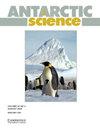生命、硅藻和一切:向Leanne Armand致敬
IF 2
4区 地球科学
Q3 ENVIRONMENTAL SCIENCES
引用次数: 0
摘要
大约10年前,在加的夫大学举办的第四届极地硅藻分类研讨会上,我第一次见到了伊梅特·莱恩·阿尔芒,我永远不会忘记和她一起对生命、硅藻和一切充满热情。硅藻是构成大多数南极海洋生态系统基础的一大类藻类。他们用二氧化硅制成微观但华丽的外壳或截头体,因此他们对环境中溶解的硅有绝对的要求。随着硅藻细胞的死亡,它们下沉,一部分被海洋沉积物掩埋。这种埋葬有助于将有机物从大气中隔离出来,但此外,它还产生了一个独特的生态和海洋条件档案。不同种类的硅藻喜欢生活在不同的条件下,比如在海冰中,而不是在开阔的海洋中,或者在寒冷和温暖的水域中。方便的是,不同的外壳形态是由基因控制的,所以经过训练的眼睛可以很容易地区分不同的物种!这意味着可以通过阅读这本书的页面来研究物种随时间的变化,从而重建海冰或水温的变化。这些古海洋学信息对于量化气候敏感性、改进气候模型和未来预测至关重要,尤其是在南大洋这样的全球气候中心地区。Leanne就是在这里找到她的学术家的。多年来,贝壳一直是她的魅力所在,她讲述了自己的童年是如何在家乡阿德莱德附近的海滩上搜寻纪念品的(Heard 2001)。她的兴趣被彻底激发,她在学校里擅长生物学,并决定在弗林德斯大学读这门课。正是在大学期间,她对化石产生了兴趣,在转到澳大利亚国立大学(ANU)后,她完成了脊椎动物古生物学的本科生研究论文(例如Armand等人,2000)。在攻读博士学位期间,她留在了澳大利亚国立大学,但她将注意力转移到了对南大洋硅藻化石的研究上,以及如何利用这些化石来重建过去海面温度和海冰范围的变化(例如,Armand 19972000,Armand等人2005)。她的职业生涯从此蓬勃发展,包括马赛艾克斯大学主办的著名欧洲博士后研究金。正是在那里,Leanne研究了南大洋的现代硅藻生态学,包括参加了Kerguelen:地表水中海洋和高原的比较研究(KEOPS)项目,这是一项在Kerguelen高原附近进行的天然铁施肥实验(Blain等人,2007;Armand等人,2008a)。随后,她搬回澳大利亚,在塔斯马尼亚和麦考瑞大学任职,然后返回澳大利亚国立大学。她被任命为澳大利亚和新西兰国际海洋发现计划联合会(ANZIC)主任,成为深海古海洋重建所需的国际科学海洋钻探工作的领导者。她仍然大量参与实践研究,包括5年前在托滕冰川探险队担任RV Investigator的第一位首席科学家。作为一名硅藻学家和微生物学家,她的论文将成为未来几年的“热门”文本,从南大洋硅藻分类学和将物种数据应用于解释过去环境条件的复杂性(例如Armand等人,2008b),到南大洋动力学和气候变化(例如Shulmeister等人,2004)。她获得的奖牌和奖项数量证明了她在整个职业生涯中取得的成就。然而,她的另一个可能更重要的遗产将是激励下一代海洋研究人员和促进女性参与科学。她是一位杰出的教育家,从高中生和本科生的热情榜样,到设计和开办硕士级海洋科学培训课程。所以,谢谢你,Leanne,你的动力和热情,最重要的是,感谢所有的硅藻。Leanne Armand于2022年1月4日不幸去世,享年53岁。这是献给她和她的家人——她的丈夫Stephane、儿子Maxime和Gaston,以及她激励的所有人。本文章由计算机程序翻译,如有差异,请以英文原文为准。
Life, diatoms and everything: a tribute to Leanne Armand
Imet Leanne Armand for the first time about 10 years ago at the 4th Polar Diatom TaxonomyWorkshop, hosted at Cardiff University, and I'll never forget enthusing with her about life, diatoms and everything. Diatoms are a major group of algae that form the basis of most Antarctic marine ecosystems. They make their microscopic but beautifully ornate shells or frustules out of silica, and so they have an absolute requirement for dissolved silicon in their environment. As the diatom cells die, they sink, and a portion becomes buried in marine sediments. This burial helps to sequester organic matter away from the atmosphere but, in addition, produces a unique archive of ecology and oceanographic conditions going back through time. Different species of diatoms prefer living under different conditions, such as in sea ice rather than the open ocean or in cold versus warm waters. Conveniently, the different shell morphologies are genetically controlled, so different species can easily be distinguished by the trained eye! This means that it's possible to examine the changes in species through time, reading the pages of this book to reconstruct changes in the extent of sea ice or water temperatures. Such palaeoceanographic information is vital for quantifying climate sensitivity and for improving climate models and future projections, especially in a place so central to the global climate as the Southern Ocean. This was where Leanne found her academic home. Shells had been a fascination of hers for years, and she spoke about how she spent her childhood combing beaches near her home city of Adelaide for mementos (Heard 2001). Her interest thoroughly sparked, she excelled at biology at school and decided to read the subject at Flinders University. It was as an undergraduate that she gained an interest in fossils, carrying out her undergraduate research thesis in vertebrate palaeontology (e.g. Armand et al. 2000) after transferring to the Australian National University (ANU). For her PhD, she stayed at ANU, but she shifted her attention to the study of diatom fossils from the Southern Ocean and how they can be used to reconstruct past changes in sea-surface temperature and sea-ice extent (e.g. Armand 1997, 2000, Armand et al. 2005). Her career boomed from there on, including a prestigious European postdoctoral fellowship hosted by Université d'Aix-Marseille. It was there that Leanne worked on modern diatom ecology in the Southern Ocean, including taking part in the Kerguelen: Compared Study of Ocean and Plateau in Surface Water (KEOPS) project, a natural iron fertilization experiment carried out near the Kerguelen Plateau (Blain et al. 2007, Armand et al. 2008a). She then moved back to Australia, taking up positions in Tasmania and Macquarie University, before returning to ANU. She was appointed the Director of the Australian and New Zealand International Ocean Discovery Program Consortium (ANZIC), becoming a leader in the international scientific ocean drilling efforts required for deep-time palaeoceanographic reconstructions. She remained heavily involved in hands-on research, including being the first chief scientist on the RV Investigator on an expedition to Totten Glacier 5 years ago. As a diatomist and a micropalaeontologist, her papers will be the 'go to' texts for years to come, ranging from Southern Ocean diatom taxonomy and the complexities of applying species data to interpretations of past environmental conditions (e.g. Armand et al. 2008b), to Southern Ocean dynamics and climate change (e.g. Shulmeister et al. 2004). The number of medals and awards she received is testament to her achievements throughout her career. However, her other perhaps more important legacy will be in the inspiration of the next generation of marine researchers and in the promotion of women in science. She was an exceptional educator, from being an enthusiastic role model for high school and undergraduate students to designing and running Masters-level marine science training courses. So, thank you, Leanne, for the motivation and your enthusiasm, and, most of all, thanks for all the diatoms. Leanne Armand sadly passed awayon 4 January 2022, aged 53. This tribute is dedicated to her and her family her husband, Stephane, and sons, Maxime and Gaston and all the people who she inspired.
求助全文
通过发布文献求助,成功后即可免费获取论文全文。
去求助
来源期刊

Antarctic Science
地学-地球科学综合
CiteScore
3.60
自引率
6.20%
发文量
42
审稿时长
3 months
期刊介绍:
Antarctic Science provides a truly international forum for the broad spread of studies that increasingly characterise scientific research in the Antarctic. Whilst emphasising interdisciplinary work, the journal publishes papers from environmental management to biodiversity, from volcanoes to icebergs, and from oceanography to the upper atmosphere. No other journal covers such a wide range of Antarctic scientific studies. The journal attracts papers from all countries currently undertaking Antarctic research. It publishes both review and data papers with no limits on length, two-page short notes on technical developments and recent discoveries, and book reviews. These, together with an editorial discussing broader aspects of science, provide a rich and varied mixture of items to interest researchers in all areas of science. There are no page charges, or charges for colour, to authors publishing in the Journal. One issue each year is normally devoted to a specific theme or papers from a major meeting.
 求助内容:
求助内容: 应助结果提醒方式:
应助结果提醒方式:


